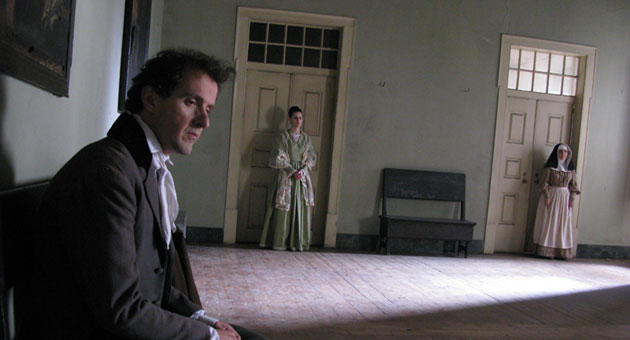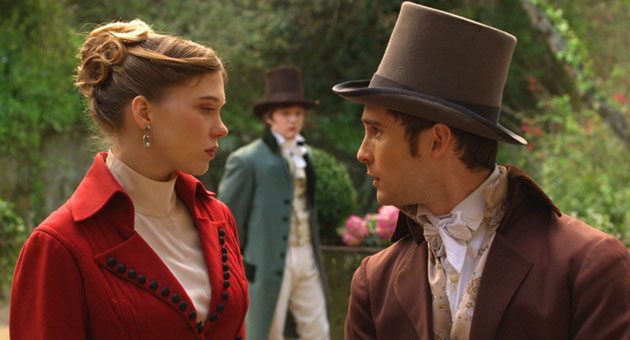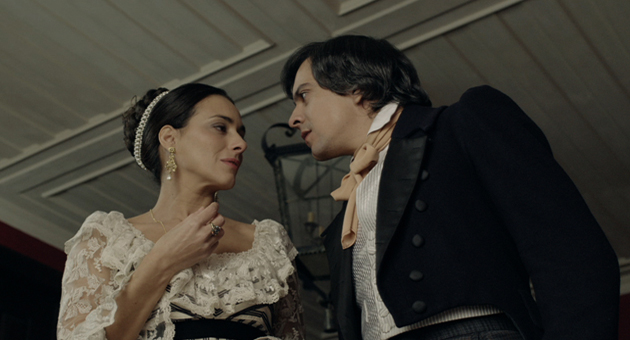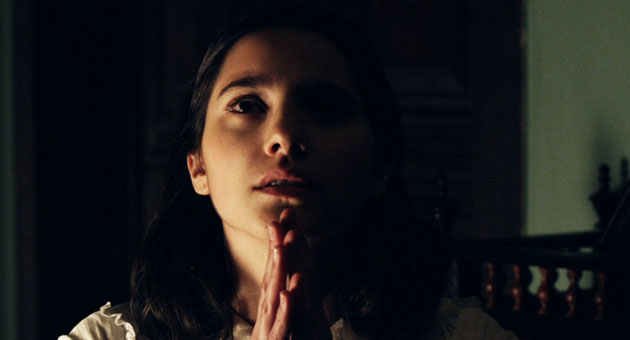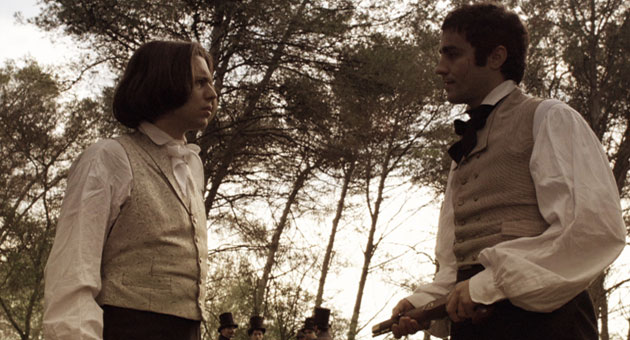Misterios de Lisboa
http://misteriosdelisboa.com
Click here for the English version
… para Justine
Hay algo muy clásico en el comienzo de cada episodio de Misterios de Lisboa (Raúl Ruiz, 2010): la majestuosa música de Jorge Arriagada acompañando las ilustraciones dibujadas de personajes y escenas que imprimen una especie de “leyenda” a la narrativa épica que vendrá a continuación. No obstante, el detalle más intrigante y encantador de este modesto prólogo es, de lejos, su toque a siglo XXI con la aparición, tanto en la serie de seis horas como en su versión cinematográfica más corta, de la URL oficial del filme. Un gesto pequeño pero significativo que se extiende más allá de la propia obra -una obra magistral, en este caso- y que alcanza los mundos del arte, la cultura, la historia y la política.
La película se sitúa, por un lado, entre la pintura clásica y la crónica novelada (1)↓ (antigüedad) y, por el otro, en la era digital (“posposmodernidad”). Su juego es bastante común, hasta Tim Burton puede practicarlo, pero al anclarlo firmemente entre esos dos polos Ruiz amarra su esencia: el cine (modernidad). El efecto-cine -el toque o la carga del cine- es lo que hace que Misterios de Lisboa se eleve muy por encima de la mayor parte de la producción actual.
Y esto ocurre ahora, cuando en muchos países estamos escuchando el cansino discurso sospechoso de una lógica muy burguesa, según el cual ¡las series televisivas nos han devuelto, en un suspiro, a la maravillosa Edad de Oro de la novela decimonónica! ¡Qué riqueza de personajes, qué compleja y apasionante trama, qué detalle profundamente descriptivo que dibuja un mundo o un ambiente! Y sí, desde luego, Misterios de Lisboa nos da todo esto; de hecho, lo hace con gran perfección y soltura; pero no se queda ahí. Porque cuando la obra de Ruiz nos sumerge en una trama familiar y romántica que se extiende a lo largo de varias generaciones y logra seducirnos, lo hace guardándose un as bajo la manga…
Lo que es sospechoso del fluido paso de la novela a la televisión es el agujero negro, el punto muerto, que queda en medio: por el camino a la pequeña pantalla (adecuada para toda esa gente fina que no quiere dejar su sala de estar) se ha dejado de lado o, incluso, elidido convenientemente la invención del cine (y su siglo de vida). El mismo cine que te sacaba de tu hogar familiar -y del espacio mental de la familia, también-. El cine como espacio de transformación y metamorfosis, no como la reconstrucción de un mundo ficcional estable y extraño (ese que nos hacen anhelar las novelas clásicas). El ideal radical del cine que Raúl Ruiz no nos puede dejar olvidar.
¿Y qué hay del otro polo opuesto del mundo en el que Misterios de Lisboa se sumerge y al que zarandea? La era digital. Ruiz también estuvo siempre al tanto de las posibilidades de este universo. En 1993, ya cavilaba sobre las posibilidades del novedoso objeto audiovisual -a medio camino entre el videojuego y la pieza artística- que estaba comenzando a explorar: una narrativa, una escena ensayada, o simplemente una puesta en escena pura (algunos cuerpos en una habitación, en un espacio) que podía ser vista desde ángulos diferentes a golpe de ratón. De tal manera que cada nueva mirada -así era como Ruiz lo imaginaba- introduciría una nueva distorsión, una nueva extrañeza en los procedimientos; cada alteración no ayudaría, pues, a reconstruir el espacio euclídeo dado, sino que lo multiplicaría, lo cuestionaría, lo haría explotar. Paso a paso, poco a poco. Este sueño tampoco era nuevo en su trayectoria: L’hypothèse du tableau vole (1979), con sus muñecos y figuras en tableaux vivants, ya exploraba, en cierto modo, esa noción de la escena. Esa pieza, además, fue también un encargo para la pequeña pantalla. Pues, para Ruiz, la televisión ha sido un espacio cultural donde, en Francia o en Chile, con dinero alemán o portugués, ha logrado encontrar un consistente y remarcable margen de libertad para dedicarse a sus mil y un experimentos. Aquí, de nuevo, podemos observar cómo Ruiz se apropia de ese universo, e incluso participa totalmente de él, pero también lo agujerea creando un espacio oscuro que no existía en ese mundo.
Lo más asombroso de Misterios de Lisboa es su muy particular concepción de la puesta en escena. Ahí reside lo maravilloso de esta obra. Para Ruiz poner en escena siempre ha sido una especie de pregunta abierta o infinita, algo provisional, artificial, citacional, esquemático, hipotético, rápido y fácilmente redibujable. La puesta en escena como una cuestión de parámetros que son dispuestos para, luego, manipularlos; planos arquitectónicos y estrategias de juego expuestas, en todo momento, a un “exterior” filosófico y artístico que viene de la mano del montaje, de la banda sonora o de la lógica asociativa (como en la infravalorada Klimt (2006)). Lo opuesto, dicho en otras palabras, a la puesta en escena entendida como expresión dramática, como creación de un mundo hípercoherente donde se subrayan las articulaciones de una trama y la psicología de unos personajes ficticios, que es lo que casi todas las series están haciendo actualmente en su triunfante marcha hacia atrás en pro de la acogedora fantasía del siglo XIX.
La figura estilística central de Misterios de Lisboa es el movimiento de cámara lateral que nos conduce con fluidez, y sin un solo corte, de una habitación a otra -hacia adelante y luego hacia atrás, durante varios minutos de una sola toma, mientras los personajes aparecen y desaparecen, luchan y aman… Una serie de secuencias que no se olvidan de los placeres convencionales del espectador -que puede disfrutar de la obra en todo momento y a todos los niveles- y que explican, en parte, el sorprendente éxito comercial de la película en varios países: hay historia, hay drama y hay personajes a los que nos apegamos e intentamos seguir, más allá del orden cronológico, de un episodio a otro porque sabemos que su destino nos será revelado. Placeres novelísticos que, de hecho, provienen de una cierta fidelidad al material original de Camilo Castelo Branco. (Tal y como señalo en el número 42 de Cahiers du cinéma España, de todos los adaptadores literarios Ruiz es, al mismo tiempo, el que inventa con más fidelidad y el que traiciona con más astucia).
En efecto, hay momentos poderosos y pasajes -la mayor parte de ellos emplazados en el cuarto episodio, seguramente el punto más álgido de toda la carrera de Raúl Ruiz, donde la interacción entre puesta en escena -entendida como diagrama paramétrico- y las retorcidas construcciones melodramáticas alcanzan el nivel de un Visconti o de un Minnelli en estado de gracia. Pero la cámara siempre en movimiento -con su inusual ritmo, con su mirada, con su cuestionamiento y con su distancia- también nos transporta, en el mismo gesto, fuera de la ficción inmediata y nos permite travesar de un lado a otro la sinuosa estructura de la obra como un todo: sus calmadas (no barrocas, para variar) ironías y convoluciones sus muchas preguntas sin responder, sus posibilidades y complicaciones sugeridas pero inexploradas, sus chistes sofocados… Con Misterios de Lisboa Ruiz ha logrado transformar completamente el Clasicismo desde su corazón estético, cultural y emocional. Y, del mismo modo, ha enriquecido el juego espacial, a menudo banal, de la cultura digital.
En este breve acercamiento todavía no he dicho gran cosa sobre los detalles específicos del argumento, de los personajes, sobre los saltos y transformaciones de Misterios de Lisboa. Soy incapaz de hacerlo tras un solo visionado -absorbente, cautivador, divertido- que tuvo lugar, de seis de la tarde hasta después de medianoche, un día inolvidable en Róterdam. Aún no entiendo ni la mitad de su argumento, lo que entendí ya lo tengo medio olvidado y me resulta difícil ordenarlo con sentido o coherencia. En parte eso es lo que hará que yo y muchos otros queramos ver la serie entera una y otra vez, tal como hicimos con Twin Peaks (1990) de David Lynch que, en términos de cine-televisión, es una aproximación mucho más cercana a Misterios de Lisboa que cualquier otra aclamada serie actual.
En realidad, yo soy el espectador ideal de este trabajo, no porque sea un rabioso “ruiziano” (que, sin duda, lo soy), sino por la misma razón por la que Ruiz se consideraba a sí mismo el adaptador ideal de El tiempo recobrado (perteneciente a En busca del tiempo perdido, Marcel Proust, 1927): porque, cuando llegó al final, se dio cuenta de que lo había olvidado todo. Y tanto en la revisión de Misterios de Lisboa, como en la concienzuda recolección de Ruiz para su adaptación de Proust (Le temps retrouvé, d’après l’oeuvre, 1999), encontramos la misma acción, el mismo proceso liberador, hasta el paroxismo, que llevó a cabo Rainer Werner Fassbinder al final de esa otra gran cine-tele-novela que es Berlin Alexanderplatz (1980): el “sueño de un sueño” de la visión de un novelista, proyectado a través del cine y luego concentrado en la pantalla de un televisor, reescrito en cada una de sus etapas y después interpretado (por nosotros, afortunados espectadores) como un palimpsesto elegante y oscuro, conmovedor y misterioso…, al que Ruiz y sus colaboradores añaden todavía otra capa suplementaria de cultura y media: esa URL.
Al final, en el último “sueño de un sueño” de Castelo Branco, Misterios de Lisboa retrocede una década en la obra de su autor y, repentina e inesperadamente, muta en Le temps retrouvé, d’après l’oeuvre como si ese filme fuese adaptado (y recuperado) una y otra vez: algunas imágenes y fragmentos vuelven a aparecer en capas que se abren al infinito, en una serie de visiones en diorama de un joven enfermo para las que, secretamente, se nos ha estado preparando. No es que Misterios de Lisboa sea como uno de esos simples rompecabezas que terminan con un giro revelador -aunque Ruiz, a menudo, ha utilizado ese recurso y ha jugado con él, por ejemplo en Tres vidas y una sola muerte (Trois vies & une seule mort, 1996) y en La comedia de la inocencia (Comédie de l’innocence, 2000)-, sino que aquí se trata de afrontar algo mucho más profundo, algo que ningún fan del director puede pasar por alto: la fuerza personal y autobiográfica de un desenlace que ejerce de clausura de una obra durante la realización de la cual el propio Ruiz estuvo a punto de morir.
De todos modos, el cine, incluso cuando se vuelve más melancólico, es el reino de la inmortalidad, de los fantasmas que caminan, se transforman y nunca mueren: esa es la magia y el misterio de las películas, y también del siglo que, una vez, las contuvo en su modernidad. Ahora, en el amanecer de otro siglo, Raúl Ruiz encuentra, con su magnífica Misterios de Lisboa, una nueva y deslumbrante forma de reactivar la infinita aventura del cine moderno.
![]()
http://misteriosdelisboa.com/
Click aquí para la versión en español
… for Justine
There is something very classical about the beginning of each episode of Raúl Ruiz’s Mysteries of Lisbon: stately music by Jorge Arriagada, accompanying drawn illustrations of characters and scenes that provide a kind of ‘legend’ to the epic narrative to follow. But by far the most intriguing and charming detail of this modest prologue is, every time, its 21st century touch: the official URL for the 6 hour series and its shorter film version. A small but telling gesture that reaches out beyond the work itself – a magisterial work, in this case – and to its circulation and place in the worlds of art, culture, history and politics.
Between classical painting and the chronicle-novel on the one side (antiquity), and the digital age on the other (post-post-modernity). It’s a common enough game; even Tim Burton can play it. But anchoring the game firmly between those poles, Ruiz holds down what is most essential: cinema (modernity). It’s the cinema-effect, the touch or charge of cinema, which makes Mysteries of Lisbon soar far above most current production.
Was Ruiz drawn to the contemporary efflorescence of long-form narrative television? To the cult of The Wire, The Sopranos, Treme, Carlos and so many similar items of the past ten years? Maybe; after all, he watches everything, and is always on the track of the latest mutations. (When he was preparing an unfortunately unmade large-budget medieval saga five years ago, I found him in his apartment closely and avidly studying the digital effects in Peter Jackson’s The Lord of the Rings.) But dreams of the extended or infinite narrative have shadowed his œuvre since Day One; Manoel on the Island of Marvels (also in different serial and theatrical cuts) is a 1980s masterpiece of this kind, and let us not forget his too-rarely seen long-form creations for Chilean television since the turn of the century, like the Chilean Rhapsody (2003), which boldly demonstrates the director’s desire to plant a tiny element in the first hour that will only, finally, be answered in the tenth or fifteenth hour. Viewers, pay attention!
In many countries right now, we are hearing the already tiresome and suspect rehearsal of a certain very bourgeois logic: that the wonderful gift of long-form narrative television is that it has returned us, in a single blow, to the Golden Age of the Nineteenth Century Novel! Such rich characters, such involved and involving plotting, such in-depth descriptive detail painting a world or a milieu! And yes, of course, Mysteries of Lisbon gives us all this, in fact superbly, overflowingly; but that is not all it gives us, and the usual seductive comforts of the ‘immersive’ family-romance plot, spanning several generations, are slid across the table to us slyly, deceptively, with a Joker in the pack …
What is suspect about the novel-to-TV spiel is the back hole left dead smack in its middle: from novel to TV (for all those fine folk who never want to leave their lounge-rooms), thus conveniently leaving out or indeed erasing the invention of cinema (and its 20th century). Cinema, which once upon a time took you out of your familiar home – and out of your familiar head-space, too. Cinema as the site of transformation and metamorphosis; not cinema as the reconstitution of a stable, singular fictional world (the type that classical novels make us yearn for). The radical ideal of cinema that Raúl Ruiz cannot ever let us forget.
What about the other extreme pole of the world into which Mysteries of Lisbon falls, and which it shakes up? The digital age. Ruiz has always been into the possibilities of that, too. In 1993 he mused about the kind of new audiovisual object – midway between video game and art-piece – he was beginning to explore: a narrative, a staged scene, or simply a pure mise en scène – some bodies in a room, a space – which could be viewed (at the click of a mouse) from different angles. But each new view would – this being a Ruiz imagining – introduce a new distortion, a new strangeness into proceedings; each alteration would not be there to help reconstitute a given Euclidean space, but to multiply it, question it, explode it. Step by step, little by little. Again, the dream was not a new one within Ruiz’s trajectory: Hypothesis of the Stolen Painting (1978), with its dolls and figures in tableaux vivants, already explored the notion of the scene in just this way. And that, too, was a television commission – TV being the cultural space where, in France or in Chile, with German or Portuguese money, Ruiz has managed to find a remarkably consistent margin of freedom in which to pursue his thousand and one experiments. Here again, we can observe that Ruiz both takes from this world, and even fully partakes in it – but also hollows out another, shadow space which is not of that world.
What is so striking about Mysteries of Lisbon, from moment to moment, is its very particular conception of mise en scène. This is the marvel of the work. Staging has always been, for Ruiz, a kind of open or infinite question, something provisional, artificial, quotational, diagrammatic, hypothetical, swiftly and easily redrawn. Mise en scène as a matter of parameters that are set out and then tinkered with, floor plans and game plans, open at every second to the philosophical and artistic ‘outside’ that is opened by montage, by the soundtrack, by associative logic (as in the underrated Klimt, 2006). The opposite, in other words, of mise en scène as dramatic expression, as hyper-coherent world-making, underlining the articulations of a plot and the psychology of fictional characters – which is what almost every other long-form tele-narrative is currently doing, on its triumphant march back to a cosy fantasy of the 19th century.
The central stylistic figure of Mysteries of Lisbon is the lateral camera movement that takes us fluidly, from room to room, without a cut – often back and forth, many times, over several minutes in a single unbroken take, as characters appear and disappear, fight and love … Conventional pleasures are not absent from these shots, or indeed from any moment or level of Mysteries of Lisbon, which is one explanation for its surprising commercial success in several countries; there is story, there is drama, there are characters we strive to keep up with as their destiny is revealed to us, out of strict chronology, from episode to episode. Novelistic pleasures, indeed, sort-of-faithfully derived from the source material by Camilo Castelo Branco. (Ruiz is at once the most inventively faithful and the most slyly treacherous of all literary adapters, as I argue in a current issue of Cahiers du cinéma España.)
Indeed, there are powerful moments and passages – the greatest number of them gathered in Episode 4, surely the highest point in the entire career of Raúl Ruiz – where the interplay of mise en scène as parametric diagram and the elaborations of tortured melodramatics reach the level of a Visconti or a Minnelli at their finest. But the ever-tracking camera – in its unusual pacing, in its regard, in its questioning and its distance – also, in the same gesture, takes us out of the immediate fiction, and across and over the sinuous structure of the work as a whole: its quiet (not baroque, for a change) ironies and convolutions, its many unanswered questions, its suggested but unexplored possibilities and complications, its muffled jokes … With Mysteries of Lisbon, Ruiz has managed to completely transform Classicism from right within its aesthetic, cultural and emotional heart. And, equally, he enriches the often banal game-space of digital culture.
I haven’t said much yet, in this short account, about the specific plot details, the characters, the vaulting moves and transformations in Mysteries of Lisbon. I am incapable of doing so after a single viewing, however absorbing and enthralling, however much fun it was, from 6pm to well after midnight one fine, unforgettable day in Rotterdam. I don’t yet understand even half of its plot, and what I did understand I have already half-forgotten, find it hard to put back together coherently or meaningfully. That’s part of what will make me, and many others, want to watch the full series again and again, just as we watched Lynch’s Twin Peaks (which is a far closer approximation, in cinema-TV terms, to Mysteries of Lisbon than any current acclaimed tele-narrative.)
In fact, I am the ideal viewer of this work – not because I am a rabid Ruizian (which I surely am) – but in just the way that Ruiz declared himself the ideal screen adapter of Time Regained: because, the moment he got to the end, he realised he had forgotten it all. And the re-viewing of Mysteries of Lisbon, like Ruiz’s painstaking recollection of Proust, is the same act and process that Rainer Werner Fassbinder set free, paroxysmically, in the finale of that other great cine-tele-novel, Berlin Alexanderplatz: the dream of a dream of a novelist’s vision, projected through cinema and then concentrated onto a TV screen, at each stage utterly reworked and then layered (for we lucky spectators) as a palimpsest at once elegant and murky, affecting and mysterious … to which Ruiz and his willing collaborators add yet another tricky level of culture and media: that URL.
At the very end, in its ultimate dream of a dream of Castilo Branco, Mysteries of Lisbon reaches back just over a decade in its auteur’s œuvre and, suddenly and unexpectedly, mutates into Time Regained as reworked (and regained) all over again: select images and narrative fragments are replayed as the feverish projections, layered to infinity, of a sick young man – which those bracketing diorama views have been preparing us for, secretly, all along. Not that Mysteries of Lisbon is any sort of simple mind-game puzzle with a revelatory twist at the end (although Ruiz has often quoted and toyed with that handy form, in Three Lives and Just One Death or The Comedy of Innocence, for example). Far more profoundly, no fan of this director can miss the nakedly personal, autobiographical force of this ending – since it caps off a work during the making of which Ruiz himself almost died.
But, even at its most melancholic, cinema is the realm of immortality, of the phantoms that walk and change and never die: that is the magic and mystery of the movies, and of the century that once contained them in its modernity. Raúl Ruiz, at the dawn of another century, finds a new and dazzling way to reopen the infinite adventure of modern cinema in his brilliant Mysteries of Lisbon.
(1)↑ Según definición del autor de este concepto, Edwin Muir, “In the chronicle novel time is not relative but absolute, and the characters and events are presented against a background of steadily elapsing time”. (Extraída de The Structure of the Novel, MUIR, Edwin; pág. 99, Londres, 1928) (Nota añadida por el equipo de traductores de Transit).
Original text © Adrian Martin March 2011. Traducción al español © Transit Marzo 2011

